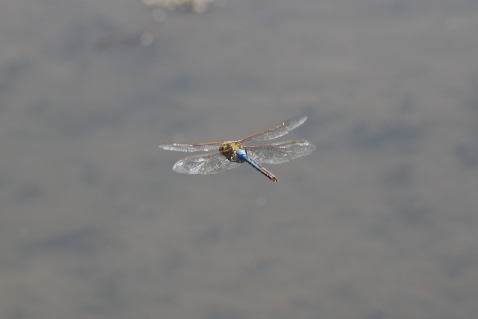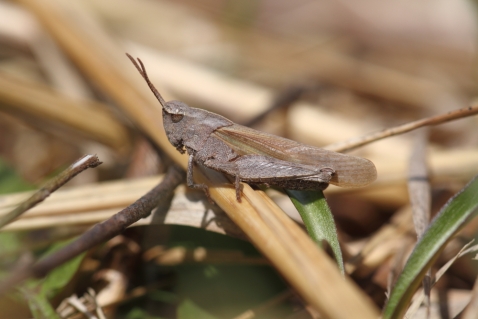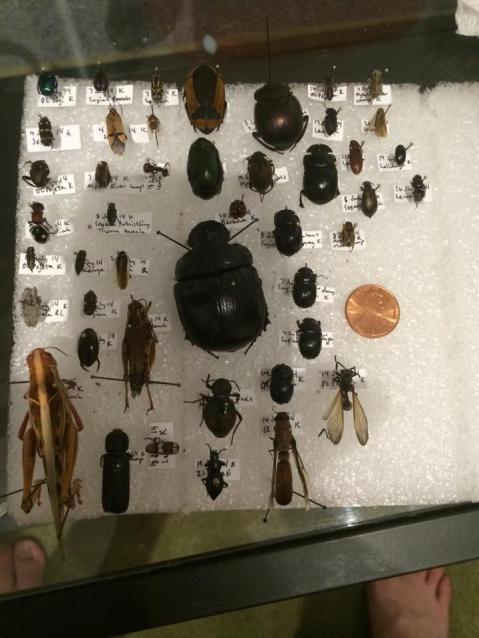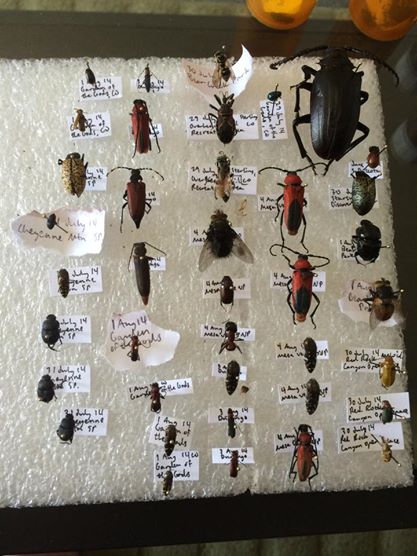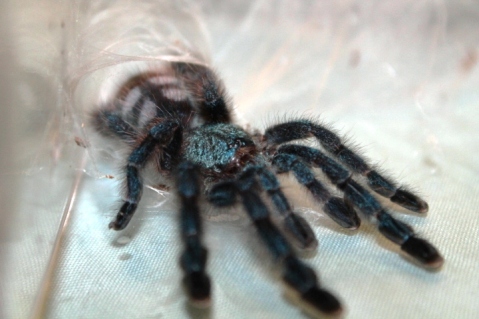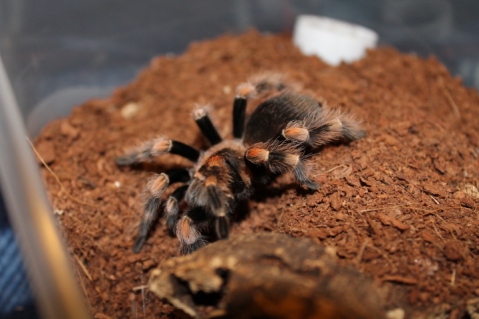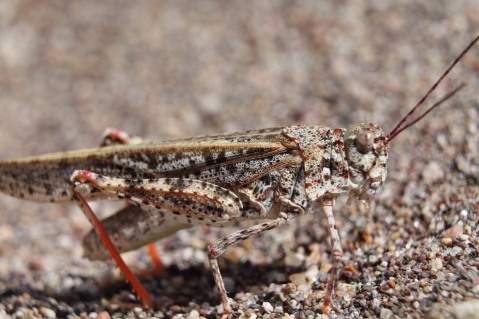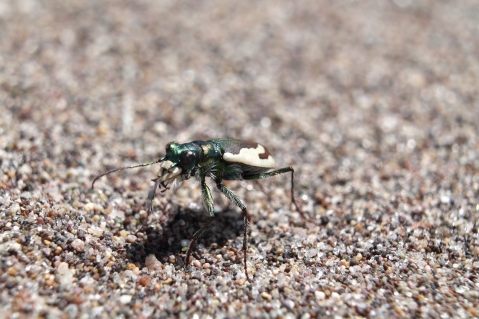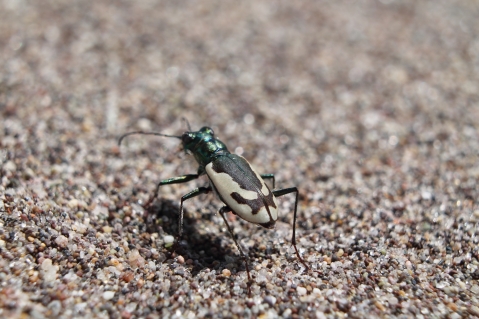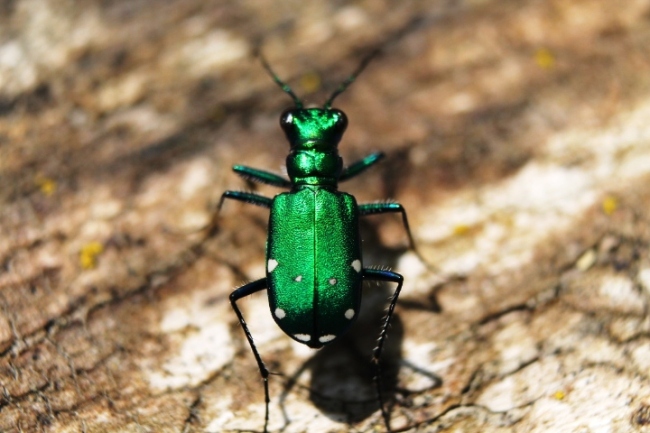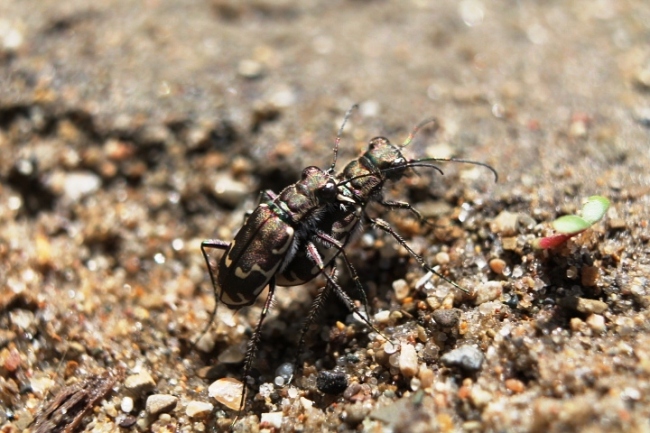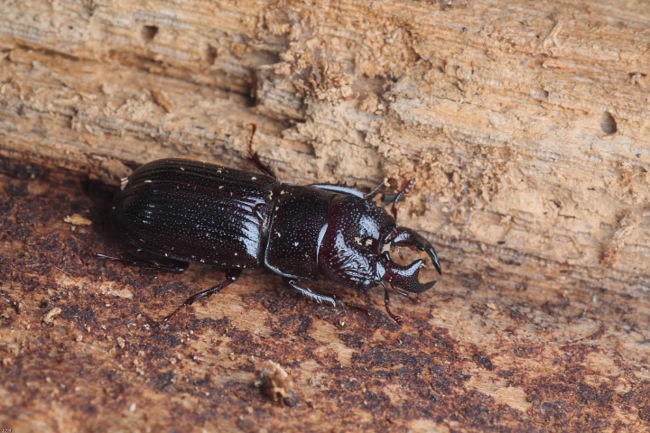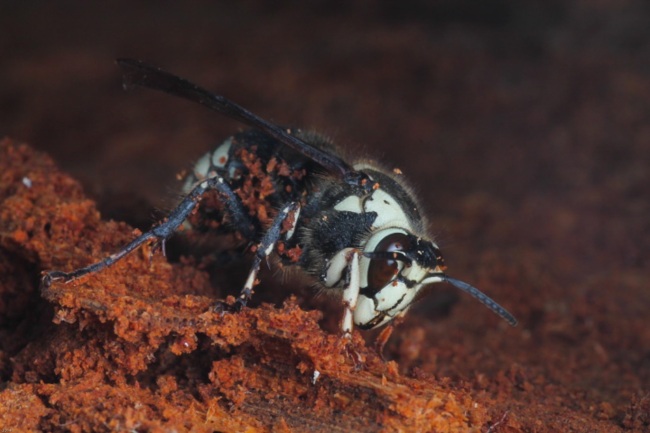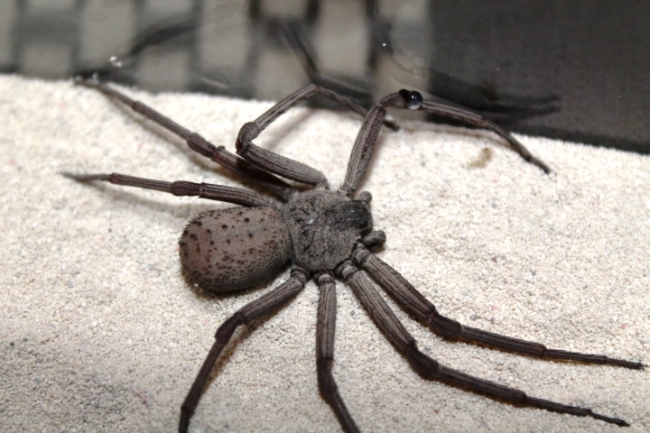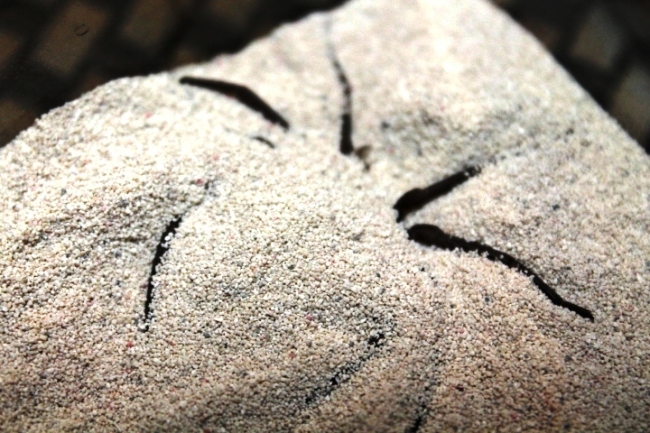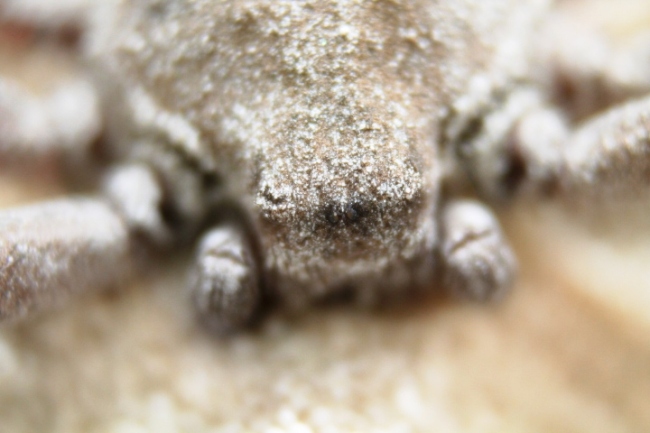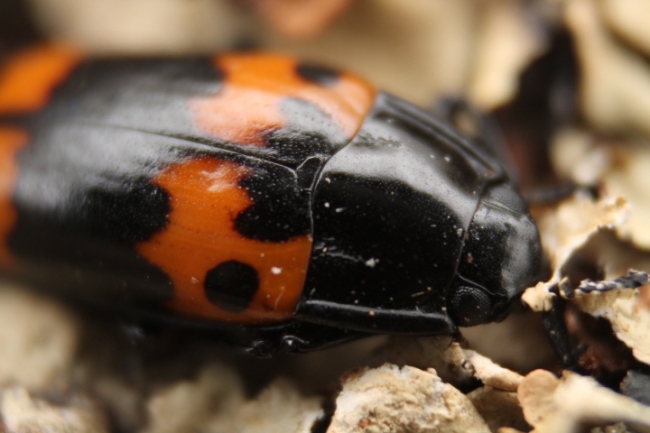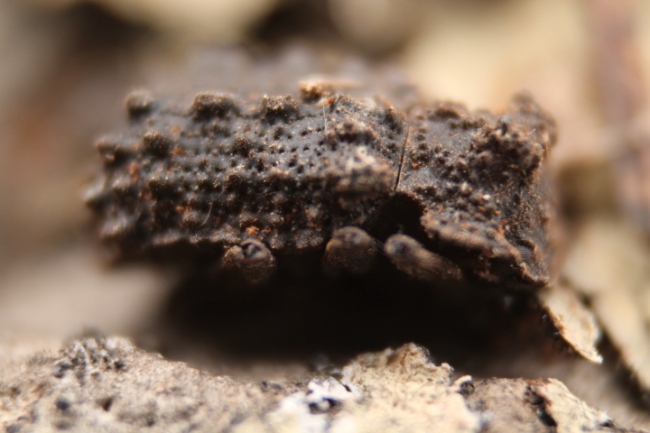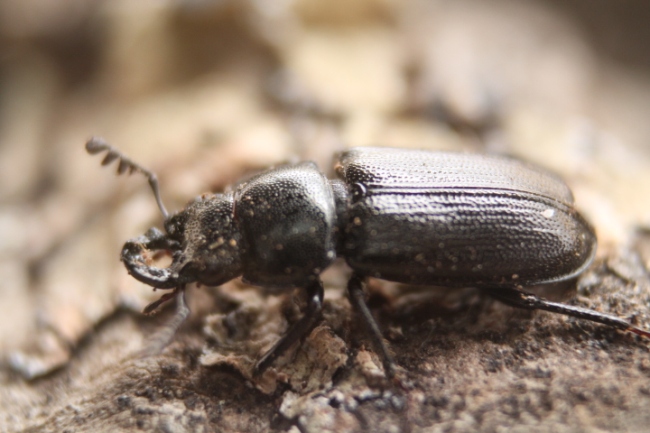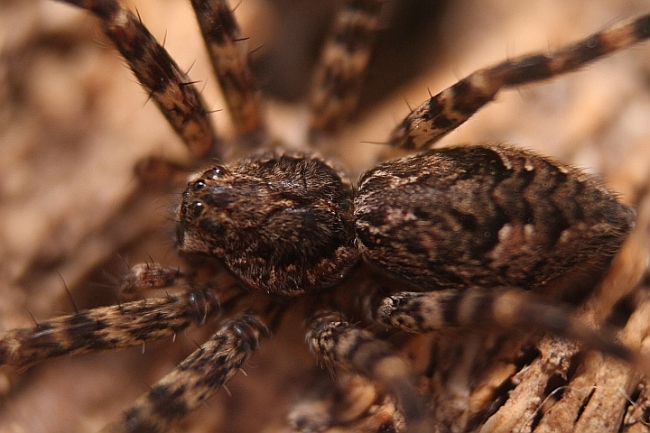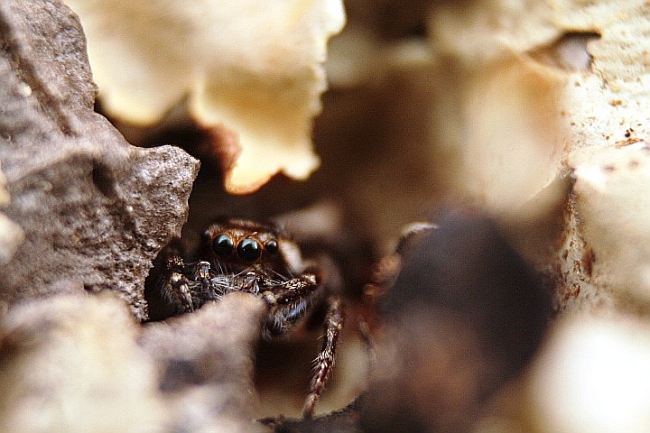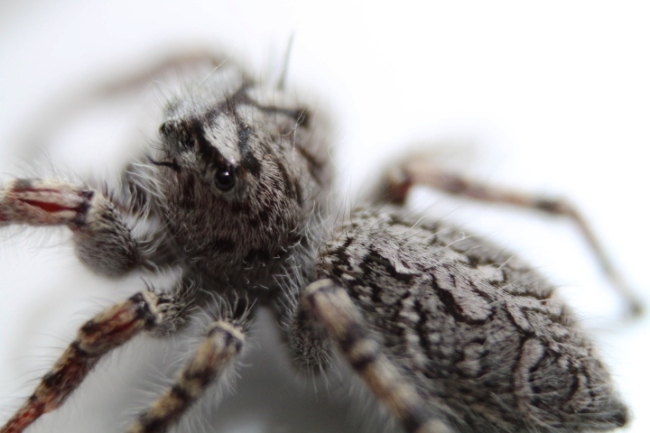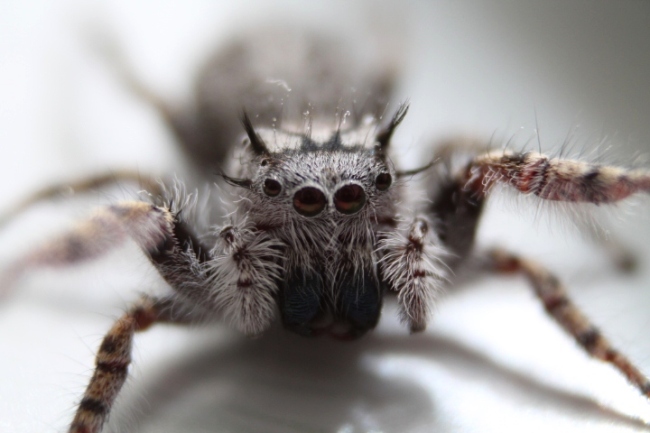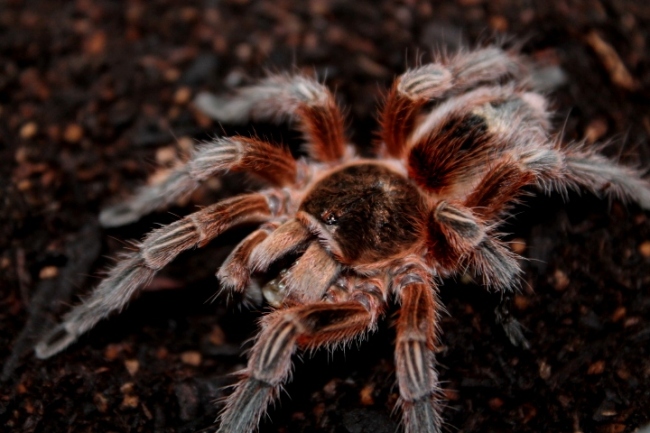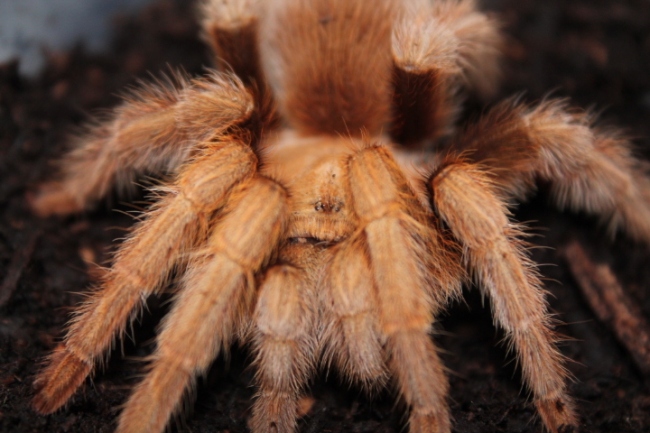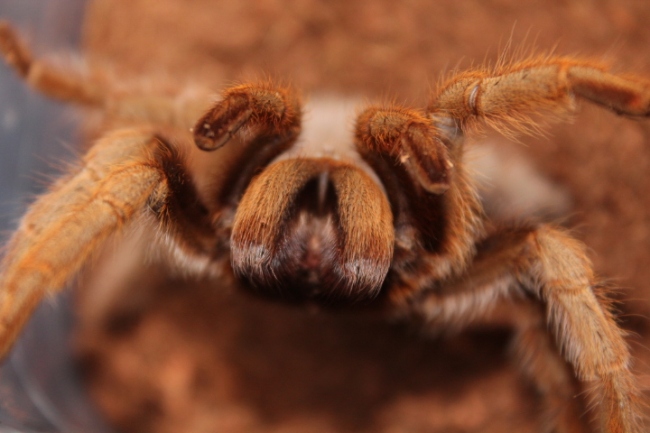Spring has Sprung!
After a rather odd winter, it seems that spring has finally arrived in central Illinois! Spring ephemeral plants are flowering and the insects have begun emerging in large numbers! Some of the things you may see are:
Common green darner (Anax junius) – this is an early migrating dragonfly species that you’ll commonly see around ponds and marshes. Look for a large dragonfly with a green body and green or blue abdomen. Warning to those wanting photographs, they never stay still! Hover shots will usually be what you get.
Butterflies such as the spring azure (Celastrina ladon), eastern comma (Polygonia comma), painted lady (Vanessa cardui), and mourning cloak (Nymphalis antiopa) can be found flying now, among many other species! I’m hoping with the warm weather this weekend to get out and photograph some of these!
For the grasshopper lover, the green-striped grasshopper (Chorthophaga viridifasciata) nymphs awoke from their winter slumber almost a month ago and finally begun molting to adulthood! This species overwinters in Illinois as late instar nymphs, meaning they have molted several times and are close to adulthood. After snacking on early spring vegetation, they were able to complete their final molts, and can be found in fields and along trails.
Even with the species I’ve listed here, it’s only touching the tip of the iceberg as more arthropods wake up and begin yet another season. Flies, bees, ants, cockroaches, beetles and more have begun to crawl about and are just out there waiting to be found.
Enjoy this spring weather, everyone! Hope you have a wonderful start to your arthropod season!
Keeping Live Invertebrates – Part II
A very short post on this page anyway because my most recent post has been featured on Entomology Hub! Very excited to have gotten this opportunity and hoping to do more work with them as time goes on.
Also, don’t forget that you can find me on Facebook and Twitter @damondiadema.
A Quick(ish) Post: An Update and My Arthropod Collection
Just wanted everyone to know that I’m still alive! I apologize for the lengthy disappearance but just wanted to catch everyone up on what has been happening since the last time.
Since the last post I’ve completed my Master’s degree and am now trying to get my work published (it will be split up into two manuscripts so there’s still lots of work ahead). I’m currently on the job boards trying to find a job, but the market is a little small at the moment. I have gotten a few interviews but nothing has panned out. There’s no need to despair though! I just need to keep applying to jobs and something will eventually work out. In the meantime though, I have been working as a field and lab technician in Dr. Sam Heads’ lab at the University of Illinois Urbana-Champaign where I have been helping survey prairie landscapes across Illinois to determine how land management techniques influence density and diversity of indicator insect species. The groups we have been looking at are:
Tiger beetles
Band wing grasshoppers
Cicadas
Butterflies

A handsome Cincindela formosa, the big sand tiger beetle
On the hobby front, I have taken up birding in the last few months to help me get through the winter weather. I’ve really enjoyed it though and plan on continuing once things warm up again. As for my pets, I have expanded significantly into roaches and widows. My goal is to own a very wide variety of widow species and successfully breed them too. Same goes for the smaller roach species, though I’ll likely get into hissing cockroaches and some of the larger species someday.
Here is my current list of pets. Before we get started though, I would like to explain what the numbers before each species means. It’s separated out into male.female.unsexed. So if you see a species that’s labeled as 0.0.1, that means that I have one unsexed individual. If there is an X where a number is, it means I have no idea how many individuals I have.
Tarantulas:
0.0.1 Avicularia metallica – Metallic pink toe
1.1.0 Brachypelma albiceps – Mexican golden red rump
0.0.1 Brachypelma albopilosum – Curly hair
0.0.3 Brachypelma emelia – Mexican red leg
1?0.1 Brachypelma smithi – Mexican red knee
0.0.4 Cyriocosmus elegans – Trinidad dwarf
0.0.2 Cyriocosmus perezmilesi – Bolivian dwarf beauty
0.0.1 Cyriocosmus ritae – Peruvian black and white
0.0.2 Grammostola rosea – Red rose hair
0.1.0 Hapalopus sp. Pumpkin Patch – Pumpkin patch
0.0.1 Hapalopus triseriatus – Lemon patch
0.0.2 Poecilotheria rufilata – Redslate ornamental
0.0.1 Psalmopoeus cambridgei – Trinidad chevron
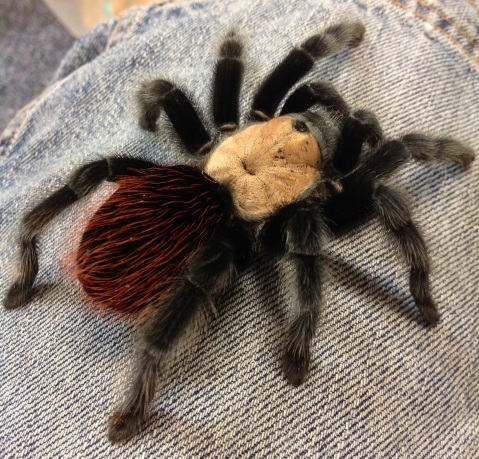
Brachypelma albiceps– Mexican golden red rump
Scorpions:
0.0.1 Anuroctonus phaiodactylus – Mafia scorpion
0.0.3 Centruroides gracilis – Florida bark scorpion
0.1.1 Hadogenes sp. – Flat rock scorpion
0.0.4 Hoffmanius spinigerus – Striped tail scorpions
0.3.0 Liocheles australiasiae – Dwarf bark scorpion
1.1.0 Orthochirus scobiculosus negebensis – Pillar tail scorpion
0.0.1 Parabuthus schlecteri – no common name
1.0.0 Rhopalurus garridoi – no common name
2.1.7 Rhopalurus junceus – Caribbean blue scorpion
1.1.0 Smeringurus mesaensis – Dune scorpion
0.0.1 Smeringurus vachoni – no common name
0.0.5 Tityus asthenes – Black devil scorpion
0.2.0 Tityus serrulatus – Brazilian scorpion(?)
0.2.0 Tityus stigmurus – Orange devil scorpion
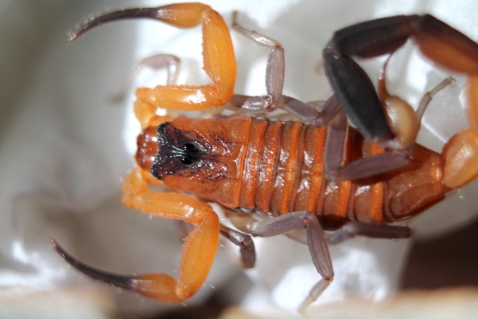
Rhopalurus junceus – Caribbean blue (yes, I know it’s orange)
Other Arachnids:
0.0.1 Damon diadema – Tanzanian whip spider
0.0.1 Paraphrynus carolynae – Sonoran whip spider
0.1.0 Kukulcania arizonensis – Sonoran black hole spider
0.1.0 Kukulcania hibernalis – Florida black hole spider
0.0.XX Loxoceles reclusa – Brown recluse
0.0.3 Sicarius sp. Chile – Sand spider
0.1.0 Heteropoda sp. Red stripe – Red stripe huntsman
0.0.4 Cupiennius salei – Red femur wandering spider
0.2.3 Latrodectus curacaviensis – Chilean widow
0.0.2 Latrodectus elegans – Hellfire widow
0.0.4 Latrodectus geometricus – Brown widow
0.0.11 Latrodectus hasselti – Redback widow
0.2.0 Latrodectus hesperus mexicanus – Western widow (subspecies)
0.2.0 Latrodectus mactans – Southern widow
0.2.2 Latrodectus sp. Mexico – Mexican widow
0.0.5 Latrodectus pallidus – White widow
0.0.10 Latrodectus tredecimgutattus – 13 spotted widow
0.2.8 Latrodectus variolus – Northern widow
1.0.4 Ischnothele caudata – Central American funnel web
0.0.5 Stegodyphus sp. – Social spider
0.0.2 Stegodyphus sp. 4 – Social spider
0.0.1 Geolycosa sp. (missouriensis?) – Burrowing wolf spider
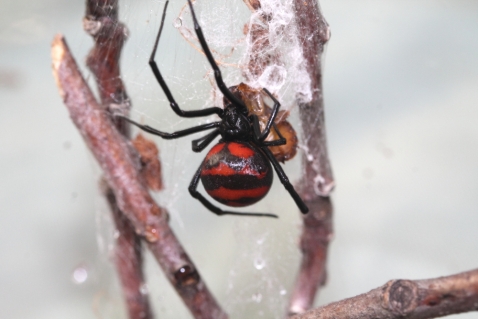
Female Latrodectus curacaviensis – Chilean widow
Insects:
2.2.2 Asbollus verrucosus – Blue death feigning beetle
0.0.5 Arenivaga tonkawa – Arizona sand roach
XX.XX.XX Blaptica dubia – Dubia roach
0.0.7 Blattella asahinai – Asian roach
0.0.19 Blattella nipponica – Japanese field roach
0.0.XX Blattellidae sp. Kenya – Little Kenyan roach
1.1.0 Corydidarum pymgaea – Roly poly roach
0.0.X Diploptera punctata – Pacific beetle mimic roach
0.0.8 Ergaula pilosa – Big black beetle mimic roach
0.0.114 Gyna caffrorum – Chrome roach
0.0.5 Gyna centurio – Centurion roach
0.0.XXX Gyna lurida – Porcelain roach
0.0.XX Oxyhaloa duesta – Red head roach
X.XX.XX Photaelia pallida – Pallid roach
0.6.0 Polyphaga sausseri – Saussere’s giant sand roach
0.0.5 Pseudomops septentrionalis – Pale bordered field roach
0.0.12 Rhabdoblatta formosana – Taiwanese leaf roach
0.0.4 Simandoa conserfariam – Extinct in the wild roach
0.0.15 Therea olegrandjeani – Question mark roach
0.0.XX Therea petiveriana – Domino roach
0.0.1 Platymeris laevicollis – Red spot assassin bug
0.0.2 Platymeris sp. Mombo – Mombo (orange spot) assassin bug
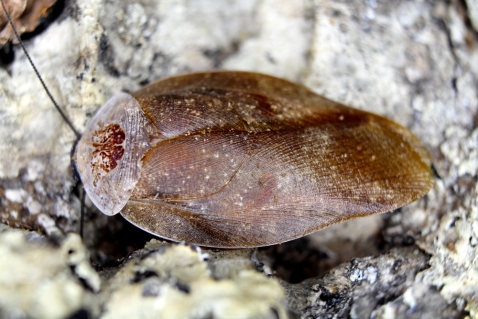
Gyna lurida – porcelain roach
Isopods:
0.0.XX Trichorhina tomentosa – Dwarf white isopods
0.0.10 Oniscus asellus – Skirted isopods
(No isopod pictures at this point)
If there’s ever a show called “Animal Hoarders” I will likely be one of the first people on there! But it’s alright because I absolutely love my collection. I’m hoping to do a string of blog posts highlighting various species so that you all can learn more about the wonderful species found in the invertebrate hobby.
Hope you all enjoyed the post!
2014 in Review
Hard to believe that another year has passed. This has by far been one of the busiest years I’ve had, but I would not trade it for anything. Besides all of the responsibilities of being a graduate student (field work, thesis, being a TA), I managed to travel pretty extensively. I spent three weeks in Kenya collecting ticks with my adviser (posts to come later) and came right back to the US to go on a family vacation to Colorado two days after returning.
Being an avid collector, I tried to get my hands on as many inverts as possible while travelling to all these amazing places, either in photos or in a vial for later pinning/identification. Always looking around yielded specimens I never thought I would obtain, which gives me even more information about an area or even the specimens themselves when I was able to observe them in their natural environments.
The insects were plentiful and the collecting was good everywhere I traveled this year. I could not have asked for more. I have been extremely fortunate and am looking forward to more in 2015.
I could post more, but with the Kenya posts in the works and a nice summary of posts below, I figured I could let you, the reader, decide what you want to read and enjoy the photos that go with each post.
January – tarantulas, bugs in cyberspace, lubbers
February – whites tree frogs
March – things with 8 legs
April – collecting trips and sand spiders
August – Great Sand Dunes National Park
December – keeping live invertebrates, year in review
For those of you on social media, you can follow Insects and Arachnids on Facebook and Twitter:
Facebook: search Insects and Arachnids
Twitter: @damondiadema
I hope you all had a great 2014 and I hope 2015 is even better!
Keeping Live Invertebrates
It has been a while since I’ve posted, but since it’s cold out I can’t really post collecting trips (though I do have a fun three part post coming up), so I thought I would give you all some info on one of my favorite hobbies. To a lot of people, keeping live invertebrates is a strange and foreign concept. Even more so when you say that it involves bunches of tarantulas, beetles, cockroaches, scorpions, amblypygids, true spiders, and mantids.
Now, I can certainly understand how some people are unnerved by this, but it is not as scary as it seems. The invert world gives hobbyists a very wide variety of creatures that they can keep as pets. I look at it as keeping several different breeds of dogs or cats. These just take up less space and have much less demanding husbandry.
For most of these creatures, all you really need is a space for an enclosure, food (which can range from vegetables and dry cat/dogfood, all the way up to live feeders, like crickets and roaches), water from time to time, and something to hide under. They really are quite simple to keep and can be very rewarding. I recently had my first peppered roach molt to adulthood and it’s an absolute beauty. Two of my mantids will be having their final molts as well within a month, so I’m very excited for that to happen.
When it comes to space, a lot of it actually goes on the keeper rather than the pet. I’ve seen people make absolutely amazing enclosures for their invert pets, while others (like me) keep them very sparse and on the smaller side. Both sides have their positives and negatives. Many keepers like to give their pet an enclosure that mimics its natural environment, even going as far as putting in live plants. The more natural the enclosure, the more work the keeper will likely have to put in, but the invert will be in a more naturalistic setting that it can enjoy. Most inverts do well with a simple enclosure and can be kept like that for their entire lives.
Another perk of keeping inverts is that they are typically short lived. Mantids won’t usually live for more than a year, and many true spider species will not live much longer than a year. Many roach species will live for 1-2 years. Now, there are always exceptions to the rule. Sand spiders (Sicarius sp.) can live for a decade and most tarantulas can live for more than 5 years, with certain genera (Brachypelma and Grammostola being most noted) can push 20-40 years! That’s a very long lived pet!
If you are thinking about buying or even going out and finding your own invert pets, do you research first. Many of these wonderful creatures have simple husbandry, but there are always exceptions to the rule and some species can be considered more advanced than others for a variety of reasons. You certainly would not want to start off with an advanced species if you have not gained experience with a starter species first! That being said, thorough research can lead to advanced species being one of the first being bought, but this likely is not what normally happens.
As an example, in the tarantula world, people typically start off with something like a rose hair (Grammostola rosea) or Mexican red knee (Brachypelma smithi), while some the more adventurous ones will start off with a species of pink toe (Avicularia sp.). These are considered to be beginner species because they are usually docile, hardy, easy to find in the pet trade, and do not have medically significant venom. After gaining some experience with these species, keepers can move on to intermediate species, such as those in the genus Psalmopoeus or Hapalopus. Some keepers skip the intermediate stage and move right to advanced species, such as those in the genus Poecilotheria or Haplopelma. Note: please only do that if you are comfortable with the species you already have, have done your research on these new species, and are willing to take on the potential hazards keeping these can present. Intermediate or advanced species are typically very skittish, can be defensive or aggressive, move very quickly (Poecilotheria will “teleport” across their enclosures), and may have medically significant venom.
For those of you that may still be on the fence about keeping live inverts as pets, there are a wide variety of orders, families, and species you can choose from. Don’t want a tarantula? You can keep beetles as pets. Feeling adventurous? Maybe a scorpion or huntsman spider is up your alley. These “bugs” are “ugly”, how bout something cute? That jumping spider on the side of your house is pretty freaking cute. Want something weird looking? Amblypygids and mantids are always a good way to go. I even know people that rear caterpillars into beautiful cecropia moths. There is something out there for everyone, especially if you hold your mind open to all the options and are willing to check out the wide world of invertebrates that we live in.
Great Sand Dunes National Park
Recently I went on a family vacation out to Colorado. While of course we were there to see the scenery and do some hiking, but I just couldn’t pass up the chance to do some collecting in a whole new state. The highlight of the trip for me had to be Great Sand Dunes National Park. This was a beautiful oddity, large sand dunes on the edge of the Rocky Mountains. Even stranger was that people could rent sand boards or sleds to go down the dunes once they reached their desired height. Looked like fun though!
One of the things that really struck me about this place was that in the visitor center there were pictures of a tiger beetle everywhere! This was something I hadn’t seen before. The staff at the park were actually trying to educate people on an insect. There were postcards, pennies, a painting, a whole display dedicated to the beetle’s ecology…it was an amazing thing to come across. Needless to say, I got very excited and wanted to try to find one of these beetles.
The Great Sand Dunes tiger beetle (Cicindela theatina) is a species endemic only to these dunes. This gives it a very small habitat and people are allowed to partake in recreational activities throughout the dunes. While this sounds like bad news for C. theatina, people aren’t as active in the places where the beetles are. Instead, they prefer to climb the dunes or play in Medano Creek. That and ATVs aren’t allowed in the park, dramatically cutting down on habitat damage (unlike what is seen at Utah’s Coral Pink Sand Dunes State Park).
After crossing the creek, I casually wandered about the vegetation before making my way up the dunes. There were plenty of small bees flying about, always catching my eye, but never being C. theatina. There were a large number of grasshoppers as well, perfectly camouflaged and springing up at the last moment.
The sparse vegetation still offered a refuge to invertebrates, especially those fleeing the hungry robber flies.
Finally I saw one! A beautiful C. theatina zipped in front of me. I got down to try to get a picture and off it went. I saw where it landed though and tried again. Same result. Third time’s the charm right? Wrong. After a couple more attempts, the beetle decided it had had enough of my nonsense and flew off where I couldn’t see it. It was a disappointing, but exhilarating moment (or should I say 15 minutes) because it meant that the beetles were here and I just had to keep trying. But first, I had to walk up the dunes with my family. The view from where we stopped was breathtaking, even if we didn’t climb the highest dune (699 feet is definitely up there, but we still managed to break 500 feet).
As they say, going up is the hard part, and how right they were. It took the better part of an hour to reach our highest point, but only about 10 minutes to get back down. Descent would have been faster with a sand board, but it was more entertaining to watch other people try that approach (spoiler: there were several people that went face-first into a dune). Once at the bottom, I beelined for a patch of vegetation to continue my search. Apparently I had chosen well, for there were at least 10 C. theatina that fled my approach. Moving much more cautiously, I managed to sneak up on a nice specimen. And then he was gone. Not to be stopped, I followed another who was running across the sands. I got close, it ran. I got close again, it ran. Repeat this several times (and include the girls that were just watching me and laughing as I army-crawled after this beetle) and finally I got my shots!
This is a gorgeous beetle, with lovely coloring and a great pattern. It cooperated with me for about a minute and then flew off to do tiger beetle things. I’m sure I could have given chase for more images, but I was just happy that I got the ones I did. This ended up being my highlight of the entire vacation, even though I did collect several very nice beetles. It’s just hard to beat a unique and rare species such as this. These beetles need to be protected so that future generations can enjoy them, from an entomological perspective and from the perspective of someone who takes joy in seeing something so small and beautiful.
For some more fun reading on C. theatina, check out this Beetles in the Bush post here.
Collecting at Kickapoo State Park (26 Apr. 2014)
With the weather on Saturday being gorgeous, it was high time to go on another collecting trip. This was a small outing (only three of us went exclusively to collect), but it was still a great time. What was really nice was that even in areas where there weren’t many things to collect, the scenery was still beautiful and there were still plenty of inverts running/flying around to make for some good pictures.
We came across loads of C. sexguttata as we wandered through the woods. Some of them were very cooperative when it came to taking pictures. Others decided we were too large and scary and would flee whenever we got close. As the day wore on and we moved to a nice, sandy area next to a creek, we found a different tiger beetle species that was much more skittish.
The handful of C. r. repanda were super skittish, flying off before we could get close. It took me about 15 minutes to get the shot above, but it was a lot of fun (even though the family fishing in the creek kept looking at me like I was crazy). This sandy area yielded many more interesting creatures, with gelastocorids (toad bugs), many different carabids (ground beetles) and a ton of frogs.
After lunch, we worked our way back into the woods again to resume collecting and break up a few logs to see what treasures they contained. The first big log we cracked into was full of termites at one end, so we shifted down a little and kept breaking. After a bit more breaking, I came across a stag beetle (Family Lucanidae)! I hadn’t come across this species before, so this was a treat! Luckily one of the other collectors had his camera ready and got some good shots.
And luckily he was ready for the surprise we found about a foot away after breaking off another piece…
All-in-all, it was a great collecting trip, with several interesting specimens being captured physically or pictorially. The trip was very enjoyable and the weather couldn’t have been better. Hopefully there will be more trips like this to come!
To see more of Horace’s photos, click here.
Sands of Death
A couple months ago, I got some new spiders. This spider is well known on YouTube for its digging, but not seen too often in the US invert hobby. These had been on my wish list for the longest time, but I couldn’t find any (or at least any offered for a decent price). I finally got lucky and managed to find three for sale. My overall goal was to get them to breed, but that’s proving to be rather difficult since I have three females.
The sand spider (Sicarius spp.), is a very reclusive spider, hailing from deserts in South America and Southern Africa. Reclusive is an accurate term, not only for their behavior of always staying hidden, but also because they are in the same family as the brown recluse (Loxoceles reclusa). Toxicology studies have shown that Sicarius have venom very similar to that of Loxoceles, so necrotic arachnidism (necrosis due to arachnid bite) is a distinct possibility. However, Sicarius are non-aggressive, almost to a fault, rarely biting or showing any aggression. They are much more likely to go running off than they are to bite.
The enclosure for Sicarius is simple. They can’t climb, so a plastic enclosure works just fine. Care must be taken though, because if the walls get dusty, the spiders can get a grip and climb. I just have a Kritter Keeper full of sand with a piece of cork bark leaning up against the side. I spray a small amount of water into a corner once a month and feeding occurs every two weeks. So far two of the females have been entertaining to watch feed (picture an eight-legged landmine), but the other one has been pretty conserved, only coming to feed after I’ve turned out the lights and gone to bed.
Overall, these are great spiders to keep. Once you get past the wicked speed and potential to be highly venomous, they are very good pets with a very unique set of adaptations.
As a final note, this is not a spider that I would recommend to the beginning hobbyist. You can blink and this spider will be on the other side of the enclosure. The redeeming qualities are that it can’t climb and is non-aggressive. Aggressiveness varies between individuals though, so if you do get a Sicarius (or really any other pet: dog, cat, bird, spider, scorpion, etc.), treat it with respect and don’t put yourself in a risky situation.
First Collecting Trip (12 April 2014)!
The weather has finally gotten nice (except for the snow today…) and I was able to go collecting! Though early in the season, there were some insects and spiders out. I went to a local forest (a rare island in the sea of corn that is central Illinois), packed and ready for a variety of things. While there wasn’t any vegetation I could use my beating sheet on, there were still plenty of logs that could be flipped or broken and lots of peelable bark.
The morning started off slow, but things picked up as the day went on and we figured out what logs and bark could yield the insects we were after. And what could a better find than a bunch of beetles???
This beautiful erotylid (pleasing fungus beetle) was under a piece of loose bark at the base of a dead tree. The same tree had a large number of dead curculionids (weevils) and coccinellids (lady beetles) under the bark. They all seemed to be infected with fungus, but that could have occurred after they died. Perhaps the frigid temps from this past winter killed them off and the fungus began breaking them down?
After waiting over a year, I was finally able to capture the amazing forked fungus beetle (Family Tenebrionidae)! She was well camouflaged in a rotting log, likely looking for fungus to eat. This is one of the few non-lucanids that show sexual dimorphism, with males having large “fork-like” horns rising over their heads. Females (like the one seen above) have small bumps. While small, they are occasionally kept in the US beetle hobby. Hopefully I’ll find a male this year so I have a pair!
The log with the B. cornutus also contained several oak stag beetles (Family Lucanidae)! This small stag beetle (maxing out at 12 mm) was a very cool find. I didn’t know this beetle existed until I found it and it was a pleasant surprise to find a lucanid so early in the season.
And on an 8-legged note, a couple flipped logs also yielded young fishing spiders (Dolomedes tenebrosus) and a jumping spider (not yet identified).
Couldn’t have asked for a better way to start the season! Here’s looking forward to collecting even more this year!
An 8-legged Update
Sorry for the delay in posting! Things got busy and I lost track of time.
As an update, there have been a few arrivals and a few losses. Such is the life of someone who keeps invertebrates as pets. I have been taking lots of pictures with the T3 and learning what it takes to capture great images, so I’ll share a few here.
RIP Snow
And Midnight
But there is always more space for invert pets! A local pet store recently got a new shipment of tarantulas and some of them are very difficult to get, including Oligoxystre diamentinensis! Even though it’s only about half an inch long, it’s already turning blue! A very exciting thing to see, but not what I picked up (not yet anyway…). Instead, I got a Chilean copper (Paraphysa scrofa) and Arizona blonde (Aphonopelma chalcodes or Aphonopelma paysoni, depending on region).
The P. scrofa is a gentle species that maxes out at around 4 inches (10 cm). Very pretty tarantula that may be worth breeding in the future!
And of all the species to give me a threat display, I got it from this guy! Normally a very calm species, but I guess this one wasn’t in the mood!
Finally, I got around to splitting up the black hole spiderlings (Kukulcania hibernalis). The mother had given me a sac at the end of last year that hatched and produced over 60 slings! I didn’t have near enough containers, so I let them cannibalize for a bit. I thought the numbers had gotten below 10, but after rounding all the little ones up, the total was still over 20. A few more than expected, but still more than enough to raise and trade or sell later on!
As a final note, if you want to see more of my pictures, you can check my ArachnoBoards picture thread here.
